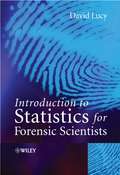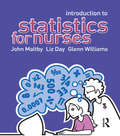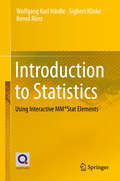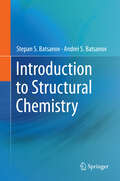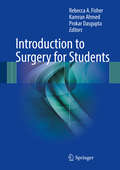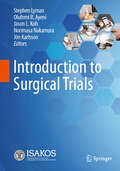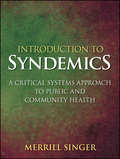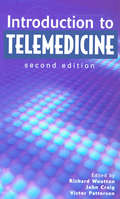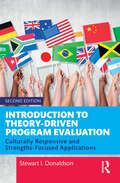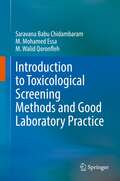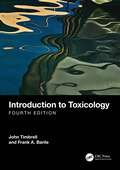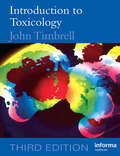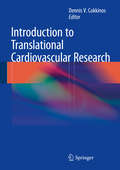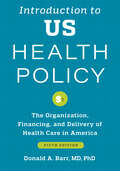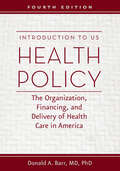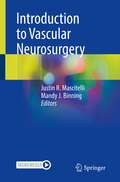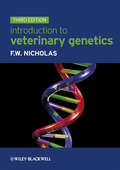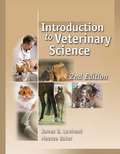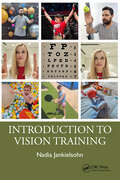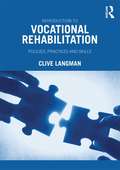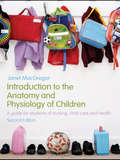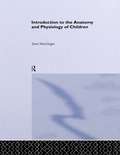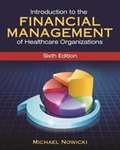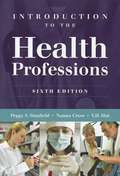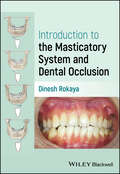- Table View
- List View
Introduction to Statistics for Forensic Scientists
by David LucyIntroduction to Statistics for Forensic Scientists is an essential introduction to the subject, gently guiding the reader through the key statistical techniques used to evaluate various types of forensic evidence. Assuming only a modest mathematical background, the book uses real-life examples from the forensic science literature and forensic case-work to illustrate relevant statistical concepts and methods.Opening with a brief overview of the history and use of statistics within forensic science, the text then goes on to introduce statistical techniques commonly used to examine data obtained during laboratory experiments. There is a strong emphasis on the evaluation of scientific observation as evidence and modern Bayesian approaches to interpreting forensic data for the courts. The analysis of key forms of evidence are discussed throughout with a particular focus on DNA, fibres and glass.An invaluable introduction to the statistical interpretation of forensic evidence; this book will be invaluable for all undergraduates taking courses in forensic science.Introduction to the key statistical techniques used in the evaluation of forensic evidenceIncludes end of chapter exercises to enhance student understandingNumerous examples taken from forensic science to put the subject into context
Introduction to Statistics for Nurses
by John Maltby Liz Day Glenn WilliamsTake the fear out of statistics with this straightforward, practical and applied book on the 'how and why' of using statistics. Introduction to Statistics for Nurses is an essential introductory text for all nursing students coming to statistics for the first time. The nursing profession involves the use of statistics every day, for example in the cases of mortality rates, average life expectancies, percentage recovery rates, average remission times, and the findings of which drugs work best with which illnesses. In fact, all of the policies that surround this job, the treatment strategies, and all the facts described above are derived from the use of statistics. This book will help students to understand the use of statistics in nursing literature, and shows how to use statistics effectively in answering research questions. Case studies throughout show how statistics are applied in nursing research and frequent exercises help to test the reader's knowledge as they progress.
Introduction to Statistics: Using Interactive MM*Stat Elements
by Wolfgang Karl Härdle Sigbert Klinke Bernd RönzThis book covers all the topics found in introductory descriptive statistics courses, including simple linear regression and time series analysis, the fundamentals of inferential statistics (probability theory, random sampling and estimation theory), and inferential statistics itself (confidence intervals, testing).Each chapter starts with the necessary theoretical background, which is followed by a variety of examples. The core examples are based on the content of the respective chapter, while the advanced examples, designed to deepen students’ knowledge, also draw on information and material from previous chapters.The enhanced online version helps students grasp the complexity and the practical relevance of statistical analysis through interactive examples and is suitable for undergraduate and graduate students taking their first statistics courses, as well as for undergraduate students in non-mathematical fields, e.g. economics, the social sciences etc.
Introduction to Structural Chemistry
by Stepan S. Batsanov Andrei S. BatsanovA concise description of models and quantitative parameters in structural chemistry and their interrelations, with 280 tables and >3000 references giving the most up-to-date experimental data on energy characteristics of atoms, molecules and crystals (ionisation potentials, electron affinities, bond energies, heats of phase transitions, band and lattice energies), optical properties (refractive index, polarisability), spectroscopic characteristics and geometrical parameters (bond distances and angles, coordination numbers) of substances in gaseous, liquid and solid states, in glasses and melts, for various thermodynamic conditions. Systems of metallic, covalent, ionic and van der Waals radii, effective atomic charges and other empirical and semi-empirical models are critically revised. Special attention is given to new and growing areas: structural studies of solids under high pressures and van der Waals molecules in gases. The book is addressed to researchers, academics, postgraduates and advanced-course students in crystallography, materials science, physical chemistry of solids.
Introduction to Surgery for Students
by Prokar Dasgupta Rebecca A. Fisher Kamran AhmedIntroduction to surgery aims to provide a one-stop guide to the basics of surgery for surgical rotations, as well as providing information for aspiring surgeons on how to explore a surgical career and build your CV for surgical applications. It aims to be the go-to companion for any student shadowing in theatres, and a thorough guide for students wishing to spend more time in a specific specialty, conduct research and plan careers. Introduction to Surgery for Students is an edited collection of 31 chapters from a group of 80 medical students, junior doctors and consultant surgeons. Each chapter has been written by a team made up of at least one student and one senior, and has then been edited and reviewed by a medical student with a special interest in the topic. This near-peer style of writing allows our content to cater to a student's needs at the right level, whilst having the expert input of surgeons who are leaders in their field.
Introduction to Surgical Trials
by Norimasa Nakamura Olufemi R. Ayeni Jón Karlsson Jason L. Koh Stephen LymanFilling a gap in literature, this book examines surgical trials with a special focus on the underlying principles, challenges, and best practices to successfully conduct rigorous surgical research.While randomized controlled trials (RCTs) remain the gold standard for evaluation of the safety and efficacy of most medical interventions, they are particularly difficult to implement successfully in the context of surgery. As a result, recruitment rates are often extremely low, crossover from non-operative to operative is common, and patients randomly allocated to surgery often simply decline to have the procedure. All of these challenges call into question the recent generalizability and fundamental quality of traditional surgical RCTs. As such, this book explores advanced alternative trial design methods and describes the current regulatory environment around the world. Designed as a practical guide, it is a valuable tool for surgeons, epidemiologist and biostatisticians involved in this challenging field.
Introduction to Syndemics
by Merrill SingerThis book explains the growing field of syndemic theory and research, a framework for the analysis and prevention of disease interactions that addresses underlying social and environmental causes. This perspective complements single-issue prevention strategies, which can be effective for discrete problems, but often are mismatched to the goal of protecting the public's health in its widest sense. "Merrill Singer has astutely described why health problems should not be seen in isolation, but rather in the context of other diseases and the social and economic inequities that fuel them. An important read for public health and social scientists. " -Michael H. Merson, director, Duke Global Health Institute "Not only does this book provide a persuasive theoretical biosocial model of syndemics, but it also illustrates the model with a wide variety of fascinating historical and contemporary examples. " -Peter J. Brown, professor of Anthropology and Global Health and director, Center for Health, Culture, and Society, Emory University "The concept of syndemics is Singer's most important contribution to critical medical anthropology as it interfaces with an ecosocial approach to epidemiology. " -Mark Nichter, Regents Professor, Department of Anthropology, University of Arizona "Merrill Singer offers the public the most comprehensive work ever written on this key area of research and policy making. " -Francisco I. Bastos, chairman of the graduate studies on epidemiology, Fundacao Oswaldo Cruz "Exquisitely describes how this new approach is a critical tool that brings together veterinary, medical, and social sciences to solve emerging infectious and non-infectious diseases of today's world. " -Bonnie Buntain, MS, DVM, diplomate, American College of Veterinary Preventive Medicine "For too long the great integrative perspectives on modern biomedicine and public health disease ecology and social medicine-have remained more or less separate. In this innovative and provocative book, Merrill Singer develops a valuable synthesis that will reshape the way we think about health and disease. " -Warwick H. Anderson, MD, PhD, professorial research fellow, Department of History and Centre for Values, Ethics, and the Law in Medicine, University of Sidney
Introduction to Telemedicine (Second Edition)
by John Craig Richard Wootton Victor PattersonIn rural and sparsely populated countries, telemedicine can be a vital and life-saving link to health care, and in those regions where demands on hospitals are ever increasing, it can provide a safe and comfortable alternative to hospital-based therapy. The second edition of this introductory guide to telemedicine and telecare services is invaluable to new practitioners in this growing field of medicine. The book describes the benefits of telemedicine and highlights the potential problems. The authors provide numerous examples of how telemedicine is used in the United States, Australia, and Scandinavia.
Introduction to Theory-Driven Program Evaluation: Culturally Responsive and Strengths-Focused Applications
by Stewart I. DonaldsonIntroduction to Theory-Driven Program Evaluation provides a clear guide for practicing evaluation science, and numerous examples of how these evaluations actually unfold in contemporary practice. A special emphasis is placed how to conduct theory-driven program evaluations that are culturally responsive and strengths-focused. In this thoroughly revised new edition, author Stewart I. Donaldson provides a state-of-the art treatment of the basics of conducting theory-driven program evaluations. Each case follows a three-step model: developing program impact theory; formulating and prioritizing evaluation questions; and answering evaluation questions. The initial chapters discuss the evolution and popularity of theory-driven program evaluation, as well as step-by-step guide for culturally responsive and strengths-focused applications. Succeeding chapters provide actual cases and discuss the practical implications of theory-driven evaluation science. Reflections, challenges, and lessons learned across numerous cases from practices are discussed. The volume is of significant value to practicing evaluators, professors of introductory evaluation courses and their students, advanced undergraduate and graduate students, and serves as a text or a supplementary text for a wide range of evaluation and applied research courses. It is also of great interest to those interested in the connections between work and health, well-being, career development, human service organizations, and organizational improvement and effectiveness.
Introduction to Toxicological Screening Methods and Good Laboratory Practice
by M. Mohamed Essa M. Walid Qoronfleh Saravana Babu ChidambaramThis book focuses on the principles, methods, and interpretation involved in establishing the safety, risk, and hazard assessment of small molecules. It presents the regulatory requirements for risk and hazard identification as per the guidelines of the Organization for Economic Cooperation and Development (OECD), Paris, and the International Council for Harmonisation (ICH) of Technical Requirements for Pharmaceuticals for Human Use ICH and Schedule ‘Y’, India. It serves as reference material for undergraduate and postgraduate pharmacy degree students as well as senior researchers to learn about the principles, methods, and interpretations of systemic dosage (acute and repeated dose) and genotoxicity (in vitro and in vivo), special toxicological investigations such as reproductive and developmental toxicology, carcinogenicity, and toxicokinetics using animal models or in vitro methods, as applicable. This book is the first of its kind in providing information on the principles and methods of implementation of Good Laboratory Practice based on the guidelines of OECD. It includes detailed chapters about the regulatory requirements and guidelines in pharmaceutical products and agrochemicals. It also describes the infrastructure needed for preclinical studies, including in vivo and in vitro facilities.
Introduction to Toxicology
by Frank A. Barile John TimbrellAs with the previous editions, Introduction to Toxicology, Fourth Edition, continues to chart the evolution of the field of toxicology, from the use of natural toxins by ancient tribes through the developments established by Paracelsus, and progresses through to the current topics in the public interest. For centuries, the study of toxicology has fascinated students. The book begins with basic toxicological principles, including an historical summary, dose-response relationships (NEW chapter), exposure-response relationships (NEW chapter), disposition, and metabolism of xenobiotic toxic substances. Other important new chapters include target organ toxicity, toxicity of carcinogenic agents and new and updated concepts in toxicity testing, and antidotes and treatment of poisonings. In all, nine new or expanded chapters from the third edition are advanced. Current concerns about the effects of therapeutic drugs, carcinogens, industrial toxins, pesticides, and herbicides on human health, animal welfare, and the stability and maintenance of the ecosystem continue to highlight toxicology as an important and growing scientific discipline. Key features: Comprehensive coverage of the field of toxicology which illustrates its importance to and impact on society Uses pertinent examples, tables, and diagrams to aid understanding with learning objectives, summaries, questions, and answers for each chapter Clearly and concisely written and presented concepts for easy comprehension by toxicology, biomedical, and health science students Examines the complex interactions associated with toxicological events Covers the effect of toxins on biological and physiological systems This book successfully condenses the diffuse literature in the field into an accessible and readable text, made easier with the insertion of many tables and figures. It introduces fundamental concepts and builds upon these using topical and relevant historical examples. Its improved format includes learning objectives and summaries of each chapter, as well as questions and answers suitable for self-assessment. This latest edition is an invaluable resource for undergraduate and graduate toxicology students, as well as an introductory text for other health care students and professionals. The book also functions as a comprehensive introductory reference text for environmental scientists, medical biologists and chemists, chemical engineers, and regulatory agencies, with interests in toxicologically related areas.
Introduction to Toxicology
by John TimbrellSince the publication of the first edition of Introduction to Toxicology , toxicology has become a more mature science, the number of undergraduate and postgraduate courses has increased and thus the need for a regularly updated introductory text has become more pressing. This third edition caters for this need in a clear and easy-to-read style, featuring:* Up-to-the-minute information* Relevant toxicological examples that reinforce principles* End-of-chapter essay questions* New and redrawn illustrations* Glossary of terms* Extensively revised bibliographyThe fundamental principles of absorption, distribution, metabolism and excretion are described in the introductory chapters, as are the types of exposure and response. In subsequent chapters these are clarified with the use of carefully chosen examples. Among the topics considered are the potential adverse effects of drugs, pesticides, food additives and industrial chemicals.
Introduction to Translational Cardiovascular Research
by Dennis V. CokkinosThe term "Translational Research" reflects today's integration of basic research ("bench") findings with the clinical practice of medicine, and in a wider scope the application of results from the individual patient ("bedside") to entire populations for the improvement of public health. This book offers future researchers a stimulus in many aspects of cardiovascular research, so as to promote their interest in future fields of cardiovascular disease, diagnosis and treatment. Introduction to Translational Cardiovascular Research discusses the fundamental and important aspects of the topic. It describes the renin-angiotensin-aldosterone system, the beta adrenergic receptors and the hypothalamic-pituitary-adrenal axis, while covering genetic polymorphisms both generally and specifically as regards the vascular endothelium and the use of microRNAs. As such, this book will be relevant to young physicians, nurses and other scientists engaged in the clinical cardiovascular field who want to added research-oriented dimension to their efforts towards better understanding and practicing of medicine. It also aims to attract young basic researchers who want to develop a better comprehension of the organism as a whole, man or animal, that they are investigating.
Introduction to US Health Policy: The Organization, Financing, And Delivery Of Health Care In America
by Donald A. BarrIntroduction to US Health Policy: The Organization, Financing, and Delivery of Health Care in America
by Donald A. BarrThe fourth edition of the essential guide to the contemporary US health care system.Winner of the CHOICE Outstanding Academic Title of the Choice ACRLHealth care reform has been a dominant theme in public discourse for decades now. The passage of the Affordable Care Act was a major milestone, but rather than quell the rhetoric, it has sparked even more heated debate. In the latest edition of Introduction to US Health Policy, Donald A. Barr reviews the current structure of the American health care system, describing the historical and political contexts in which it developed and the core policy issues that continue to confront us today.Barr’s comprehensive analysis explores the various organizations and institutions that make the US health care system work—or fail to work. He describes in detail the paradox of US health care—simultaneously the best in the world and one of the worst among developed countries—while introducing readers to broad cultural issues surrounding health care policy, such as access, affordability, and quality. Barr also discusses specific elements of US health care with depth and nuance, including insurance, especially Medicare and Medicaid. He scrutinizes the shift to for-profit managed care while analyzing the pharmaceutical industry, issues surrounding long-term care, the plight of the uninsured, the prevalence of medical errors, and the troublesome issue of nursing shortages. The thoroughly updated edition of this widely adopted text focuses on the Affordable Care Act. It explains the steps taken to carry out the Act, the changes to the Act based on recent Supreme Court decisions, the success of the Act in achieving the combined goals of improved access to care and constraining the costs of care, and the continuing political controversy regarding its future. Drawing on an extensive range of resources, including government reports, scholarly publications, and analyses from a range of private organizations, Introduction to US Health Policy provides scholars, policymakers, and health care providers with a comprehensive platform of ideas that is key to understanding and influencing the changes in the US health care system.
Introduction to Vascular Neurosurgery
by Justin R. Mascitelli Mandy J. BinningThis book aims to cover the majority of neurovascular diseases and management. The first section reviews neurovascular anatomy, the basics of angiography, and the basics of craniotomies for neurovascular diseases. Next, an entire section is devoted to intracranial aneurysms, covering the natural history, subarachnoid hemorrhage, endovascular management, microsurgical management, and vasospasm. Following this, a number of chapters are devoted to stroke including natural history, mechanical thrombectomy, intracranial stenosis, Moyamoya disease, bypass surgery, vertebrobasilar insufficiency, intracerebral hemorrhage, sinus thrombosis, and the surgical and endovascular management of extracranial carotid disease. Next, the text covers vascular malformations including arteriovenous malformation, arteriovenous fistulas, carotid cavernous fistulas, vein of Galen malformations, spinal malformations, and cavernous malformations. Finally, the book discusses a few miscellaneous topics including more recent advances in neurovascular care such as venous sinus stenting for idiopathic intracranial hypertension and middle meningeal artery embolization for subdural hematoma. Written by experts in the field, Introduction to Vascular Neurosurgery provides a comprehensive summary of neurovascular disease and management. The book can be used as a daily reference and serves as a trusted resource for medical students, residents, fellows, and young attendings.
Introduction to Veterinary Genetics
by Frank W. NicholasThe concepts of veterinary genetics are crucial to understanding and controlling many diseases and disorders in animals. They are also crucial to enhancing animal production. Accessible and clearly presented, Introduction to Veterinary Genetics provides a succinct introduction to the aspects of genetics relevant to animal diseases and production. Now in its third edition, this is the only introductory level textbook on genetics that has been written specifically for veterinary and animal science students.Coverage includes: basic genetics, molecular biology, genomics, cytogenetics, immunogenetics, population genetics, quantitative genetics, biotechnology, and the use of molecular tools in the control of inherited disorders. This book describes in detail how genetics is being applied to artificial selection in animal production. It also covers the conservation of genetic diversity in both domesticated and wild animals.New for the Third Edition:End-of-chapter summaries provide quick recaps.Covers new topics: epigenetics, genomics and bioinformatics.Thoroughly revised according to recent advances in genetics.Introduction to Veterinary Genetics is still the only introductory genetics textbook for students of veterinary and animal science and will continue to be an indispensable reference tool for veterinary students and practitioners alike.
Introduction to Veterinary Science
by James B. Lawhead Meecee BakerAn introductory level text which begins with basic cell biology and tissue function, followed by the musculoskeletal, circulatory, respiratory, renal, digestive, reproductive, nervous, endocrine, and immune systems. Nutrition and diseases are covered in depth, including infectious disease principles, prevention, classification, zoonoses, and diagnosis. The final section addresses surgery. Appendices address decision-making and veterinary careers, and provide a glossary. Cases are discussed throughout, with color photographs, diagrams, and charts. (We contemn the 2005 copyright date in a book that is out in August 2003) Annotation (c)2003 Book News, Inc. , Portland, OR (booknews. com)
Introduction to Vision Training
by Nadia JankielsohnThis book addresses the limited information on vision training and the importance of having knowledge of superior visual skills in our everyday, individualised environment including the classroom, workspace, and sports setting. It is an instruction manual explaining vision training in terms of what it can be used for and who can benefit from it. The manual provides examples of over 200 exercises of 23 different visual skills, covering fundamental and advanced skills, also including visual perceptual skills and sport-specific skills. It explains the tests that an eye-care professional can do to determine the level of a patient/athlete’s visual skills to regulate where improvement needs to be done. Written in a concise manner and supplemented with insightful visual materials, the book will allow the reader to formulate an individualised program according to the needs of the patient/athlete.
Introduction to Vocational Rehabilitation: Policies, Practices and Skills
by Clive LangmanThis text provides an overview of vocational rehabilitation (VR) practice, making it the perfect companion for students and practitioners with an interest in supporting people back to work and improving their sense of health and well-being. The book is divided into three parts: the first covers the policy context of VR in the UK, defining VR, outlining the development of national standards in the sector, and looking at issues such as the economy and worklessness, and the legal background. The second part examines models of VR practice and relevant standards. It explores the nature of developing services in the public and private sectors, illustrated by case studies from a range of disciplinary backgrounds. The final part presents a detailed introduction to the knowledge and skills required in providing a VR service, including consideration of the multidisciplinary processes and stages involved. Introduction to Vocational Rehabilitation includes numerous case studies and a dedicated chapter of issues and questions to aid reflection. Comprehensive and evidence-based, this is the first multidisciplinary textbook for students and practitioners from a range of backgrounds, including occupational therapy and health, physiotherapy, human resources, nursing, social work and health psychology.
Introduction to the Anatomy and Physiology of Children: A Guide for Students of Nursing, Child Care and Health
by Janet MacGregorFully updated, this new edition provides an introduction to normal, healthy physical development for all professionals who specialise in working with children. The author, an experienced nurse teacher, guides the reader through the key changes in body systems and functions from embryo to birth through childhood and adolescence. Chapter 1 sets the scene for physical needs in child development, such as the need to be warm and safe. Chapters 2 to 9 cover the body systems: skeletal; nervous; cardiovascular; respiratory; renal; digestive; reproductive; and immune. The embryology and physiological function at birth is explored in each chapter before the text moves on through the many changes over the next decade to puberty and the arrival at adult functioning. A new final chapter provides a holistic account of children’s development, body and mind. Each chapter is illustrated with line drawings and tables, and ends with scenarios which illustrate how knowledge supports good practice in a real-life situation, and a quiz to consolidate learning. Concise and clearly written, this introductory text will be essential reading for all those working with children and families in the health and social care sector, enabling them to ensure children enjoy a safe and healthy childhood in line with Every Child Matters and new national service framework directives.
Introduction to the Anatomy and Physiology of Children: A Guide for Students of Nursing, Child Care and Health
by Janet MacGregorPublished in 2002, 'Introduction to the Anatomy and Physiology of Children' is a valuable addtion to Allied Health.
Introduction to the Financial Management of Healthcare Organizations (Gateway to Healthcare Management)
by Michael NowickiNew information on capitation, entitlement reform, cost-benefit and cost-effectiveness analyses, and financial statements Recent legal action related to the distinctions between for-profit and not-for-profit hospitals Information regarding federal government actions against providers on fraud and abuse allegations
Introduction to the Health Professions (Sixth Edition)
by Nanna Cross Y. H. Hui Peggy S. StanfieldCompletely updated, Introduction to the Health Professions, Sixth Edition provides the most current, comprehensive coverage of all the major health professions. This popular text outlines more than 75 careers and touches on every major facet of the field including training requirements, job responsibilities, and salaries. This fundamental resource provides a thorough review of the U. S. healthcare delivery system, managed care, health care financing, reimbursement, insurance coverage, Medicare, Medicaid, and the impact of new technology on healthcare services. Written specifically for students who plan to become healthcare professionals, this text will give you all the information you need for a successful career! New Topics and Updates in the Sixth Edition Historical review of the health insurance industry in the United States Expanded discussion of public health care--Medicaid, Medicare, and Children's Health Insurance Program (CHIP)New section on healthcare reform due to the Patient Protection and Affordable Care Act of 2010Up-to-date coverage of individual states' implementation of healthcare reform Future-looking perspective on the evolving roles and responsibilities in health careers and the impact of future demographic and socioeconomic changes on healthcare needs Useful information on educational grants and loan repayment programs Current data for each profession from the latest Occupational Outlook (U. S. Department of Labor, 2010 - 2011)New chapter with current information on athletic trainers Instructor Resources: Transition Guide, Instructor's Manual, PowerPoint Presentations, and a Test Bank. Student Resources: Companion Website Instructors: Bundle this product with additional Jones & Bartlett introductory health professions texts and save your students up to 30% off list price. Contact your Account Specialist for more information.
Introduction to the Masticatory System and Dental Occlusion
by Dinesh RokayaA comprehensive introduction to the masticatory system and its relation to dental occlusion Introduction to the Masticatory System and Dental Occlusion meets the need for a rigorous guide to the masticatory system and how it relates to dental occlusion to aid interventions. The text offers a sound understanding of functioning dental anatomy and the biomechanics that are essential to understanding dental occlusion. It covers all structures required for chewing: jaws and jaw muscles, teeth, joints, and tongue as well as other significant areas including the vascular and nervous systems that supply these structures with blood and stimulation. Beginning with the understanding of these concepts, the author provides further guidance on oral function, esthetics, and alerting patients to potential issues. Introduction to the Masticatory System and Dental Occlusion readers will also find: A thorough introduction to the basic structure and function of the masticatory systemDetailed coverage of subjects including TMJ, mastication muscles, occlusal therapy, and more Images to illustrate key concepts and systems Advice on choosing the correct medical intervention in each case Introduction to the Masticatory System and Dental Occlusion is ideal for undergraduate and postgraduate dental students for subjects such as masticatory systems, dental anatomy, restorative dentistry, and prosthodontics, as well as for practicing dentists and medical professionals in related fields.
